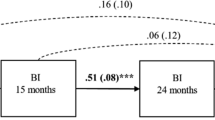Abstract
In typically developing children, researchers have found that anxiety disorders are associated with poorer intellectual abilities (Davis et al. Journal of Psychopathology and Behavioral Assessment 30:43–51, 2008). The aim of the current study was to examine the impact anxiety symptoms had on the developmental quotients of toddlers. A total of 170 toddlers ranging in age from 17 to 37 months were selected for inclusion in this study, all of whom were at risk for or had a developmental delay. Two factors indicative of behavioral symptoms of anxiety from the Baby and Infant Screen for Children with aUtIsm Traits-Part2 were utilized as the independent variables and the total developmental quotient from the Battelle Developmental Inventory, 2nd Edition was utilized for the dependent variable. Examination of results revealed that atypically developing toddlers with symptoms of anxiety had significantly lower developmental quotients when compared to toddlers without any anxiety symptoms. A discussion of the implications and limitations of this study are included.

Similar content being viewed by others
References
Baron, R. M., & Kenny, D. A. (1986). The moderator-mediator variable distinction in social psychological research: conceptual, strategic and statistical considerations. Journal of Personality and Social Psychology, 51, 1173–1182.
Bryant, B. J., & Cheng, K. (2005). Anxiety disorders. In K. Cheng & K. M. Myers (Eds.), Child and adolescent psychiatry: The essentials (pp. 111–132). Philadelphia: Lippincott Williams & Wilkins.
Cleary, P., & Kessler, R. (1982). The estimation and interpretation of modifier effects. Journal of Health and Social Behavior, 23, 159–169.
Davis, T. E., III. (2009). PTSD, anxiety, and phobias. In J. Matson, F. Andrasik, & M. Matson (Eds.), Treating childhood psychopathology and developmental disorders (pp. 183–220). New York: Springer Science and Business Media, LLC.
Davis, T. E., III, Ollendick, T. H., & Nebel-Schwalm, M. (2008). Intellectual ability and achievement in anxiety-disordered children: a clarification and extension of the literature. Journal of Psychopathology and Behavioral Assessment, 30, 43–51.
Davis, T. E., III, Munson, M., & Tarzca, E. (2009). Anxiety disorders and phobias. In J. Matson (Ed.), Social behavior and social skills in children (pp. 219–244). New York: Springer Science and Business Media, LLC.
Davis, T. E., III, Fodstad, J. C., Jenkins, W., Hess, J. A., Moree, B. N., Dempsey, T., et al. (2010a). Anxiety and avoidance in infants and toddlers with autism spectrum disorders: evidence for differing symptom severity and presentation. Research in Autism Spectrum Disorders, 4, 305–313.
Davis, T. E., III, Hess, J. A., Moree, B. N., Fodstad, J. C., Dempsey, T., Jenkins, W., et al. (2010b). Anxiety symptoms across the lifespan in people with autistic disorder. Research in Autism Spectrum Disorders.
Evans, D., Canavera, K., Kleinpeter, F., Maccubbin, E., & Taga, K. (2005). The fears, phobias, and anxieties of children with autism spectrum disorders and down syndrome: comparisons with developmentally and chronologically age matched children. Child Psychiatry and Human Development, 36, 3–26.
Gillott, A., Furniss, F., & Walter, A. (2001). Anxiety in high functioning children with autism. Autism, 5, 277–286.
Hodges, K., & Plow, J. (1990). Intellectual ability and achievement in psychiatrically hospitalized children with conduct, anxiety, and affective disorders. Journal of Consulting and Clinical Psychology, 58, 589–595.
Kashani, J. H., & Orvaschel, H. (1990). A community sample of anxiety in children and adolescents. Journal of American Psychiatry, 147, 313–318.
Kessler, R. C., Berglund, P., Demler, O., Jin, R., Merikangas, K. R., & Walters, E. (2005a). Lifetime prevalence and age-of-onset distributions of DSM-IV disorders in the National Comorbidity Survey Replication. Archives of General Psychiatry, 62, 593–603.
Kessler, R. C., Chiu, W. T., Demler, O., & Walters, E. (2005b). Prevalence, severity, and comorbidity of 12-month DSM-IV disorders in the National Comorbidity Survey Replication. Archives of General Psychiatry, 62, 617–627.
Leyfer, O. T., Folstein, S. E., Bacalman, S., Davis, N. O., Dinh, E., Morgan, J., et al. (2006). Comorbid psychiatric disorders in children with autism: interview development and rates of disorders. Journal of Autism and Developmental Disorders, 36, 849–861.
Matson, J. L., Boisjoli, J., & Wilkins, J. (2007). The Baby and Infant Screen for Children with aUtIsm Traits (BISCUIT). Baton Rouge: Disability Consultants, LLC.
Matson, J. L., Fodstad, J. C., & Mahan, S. (2009a). Cutoffs, norms, and patterns of comorbid difficulties in children with developmental disabilities on the Baby and Infant Screen for Children with aUtIsm Traits (BISCUIT-Part2). Research in Developmental Disabilities, 30, 1221–1228.
Matson, J. L., Fodstad, J. C., Mahan, S., & Sevin, J. A. (2009b). Cutoffs, norms, and patterns of comorbid difficulties in children with an ASD on the Baby and Infant Screen for Children with aUtIsm Treats (BISCIUT-Part2). Research in Autism Spectrum Disorders, 3, 977–988.
Matson, J. L., Wilkins, J., Sevin, J. A., Knight, C., Boisjoli, J. A., & Sharp, B. (2009c). Reliability and Item Content of the Baby and Infant Screen for Children with aUtIsm Traits(BISCUIT): Parts 1, 2, and 3. Research in Autism Spectrum Disorders, 3, 336–344.
Matson, J. L., Boisjoli, J. A., Hess, J. A., & Wilkins, J. (2010). Comorbid psychopathology factor structure on the Baby and Infant Screen for Children with aUtIsm Traits-Part 2 (BISCUIT-Part 2). Manuscript submitted for publication.
Moree, B., & Davis, T. E., III. (2010). Cognitive-behavioral therapy for anxiety in children diagnosed with Autism Spectrum Disorders: modification trends. Research in Autism Spectrum Disorders, 4, 346–354.
Newborg, J. (2005). Battelle Developmental inventory (2nd ed.). Itasca: Riverside.
Smith, K. W., & Sasaki, M. S. (1979). Decreasing multicollinearity. Sociological Methods and Research, 8, 35–56.
Zimet, S. G., Zimet, G. D., Farley, G. K., & Adler, S. S. (1994). Comparisons of intellectual performance among children with psychiatric disorders. Journal of Clinical Psychology, 50, 131–137.
Author information
Authors and Affiliations
Corresponding author
Rights and permissions
About this article
Cite this article
Davis, T.E., Hess, J.A., Matthews, R.A. et al. The Moderating Effect of Anxiety on Development in Atypically Developing Toddlers. J Psychopathol Behav Assess 33, 171–177 (2011). https://doi.org/10.1007/s10862-010-9194-5
Published:
Issue Date:
DOI: https://doi.org/10.1007/s10862-010-9194-5




